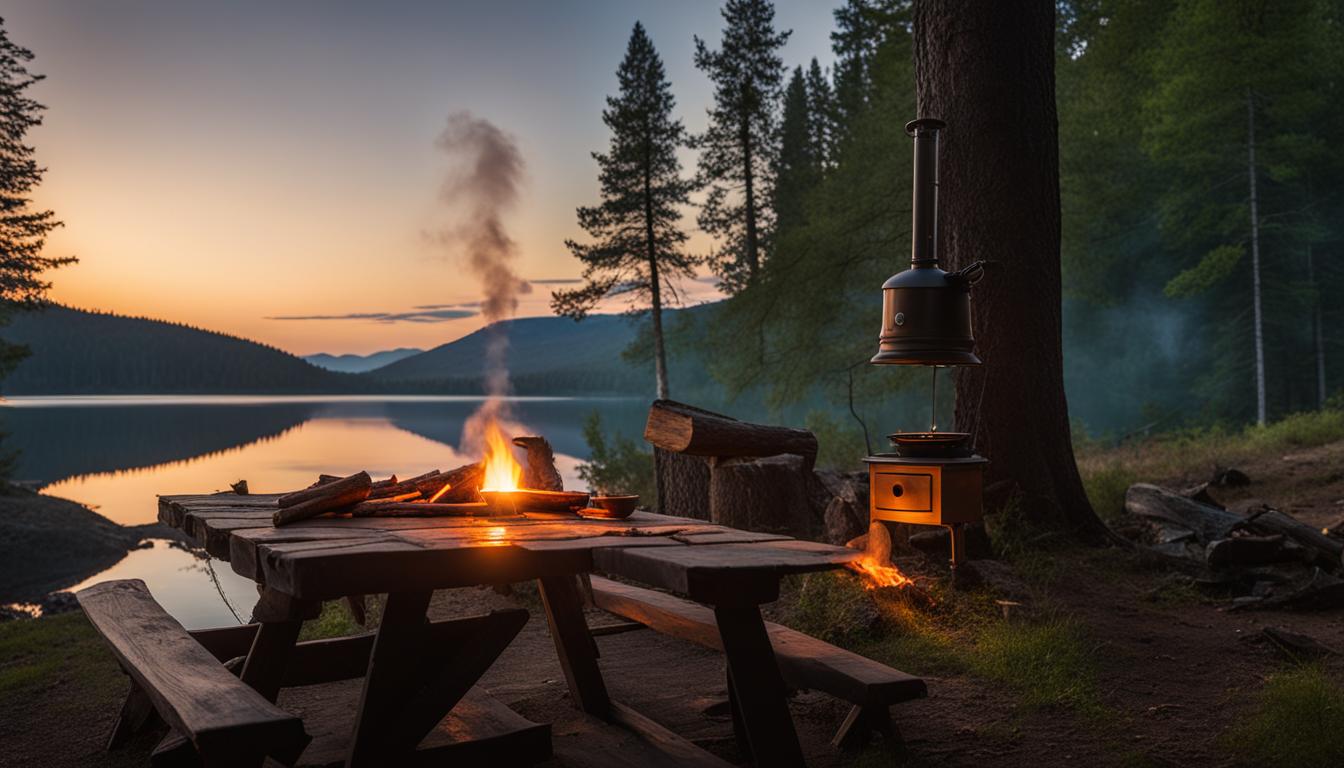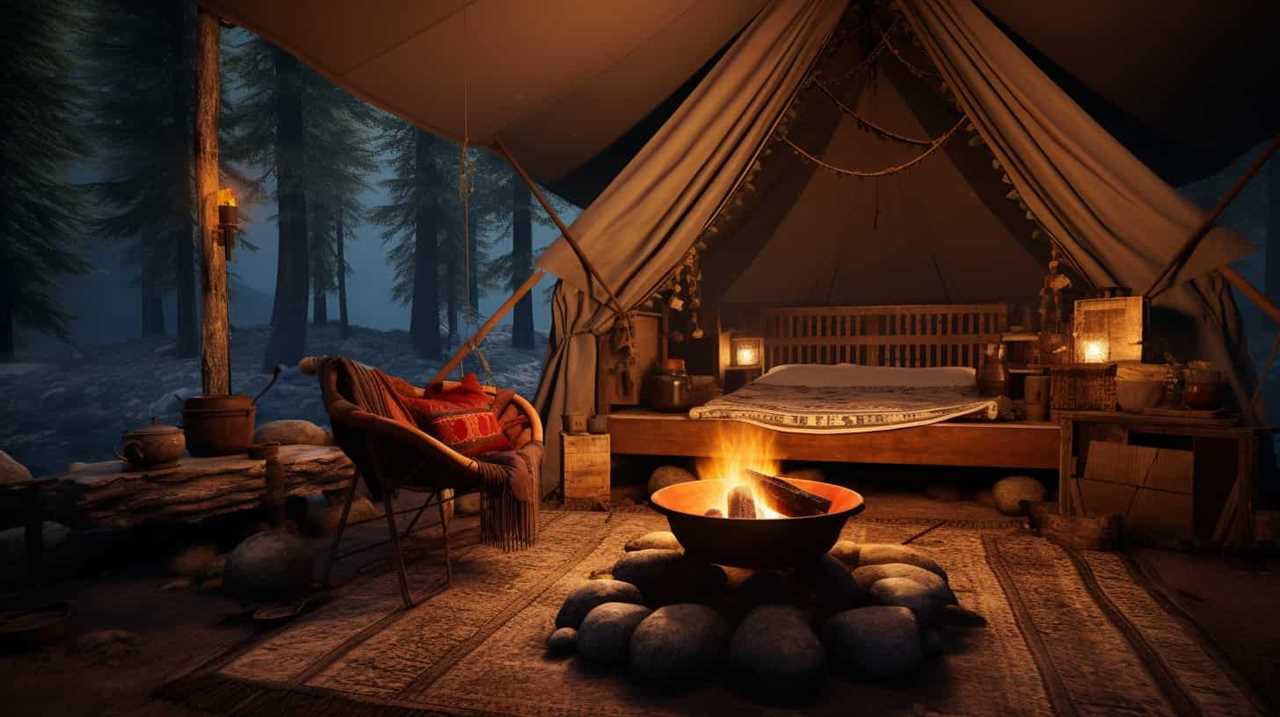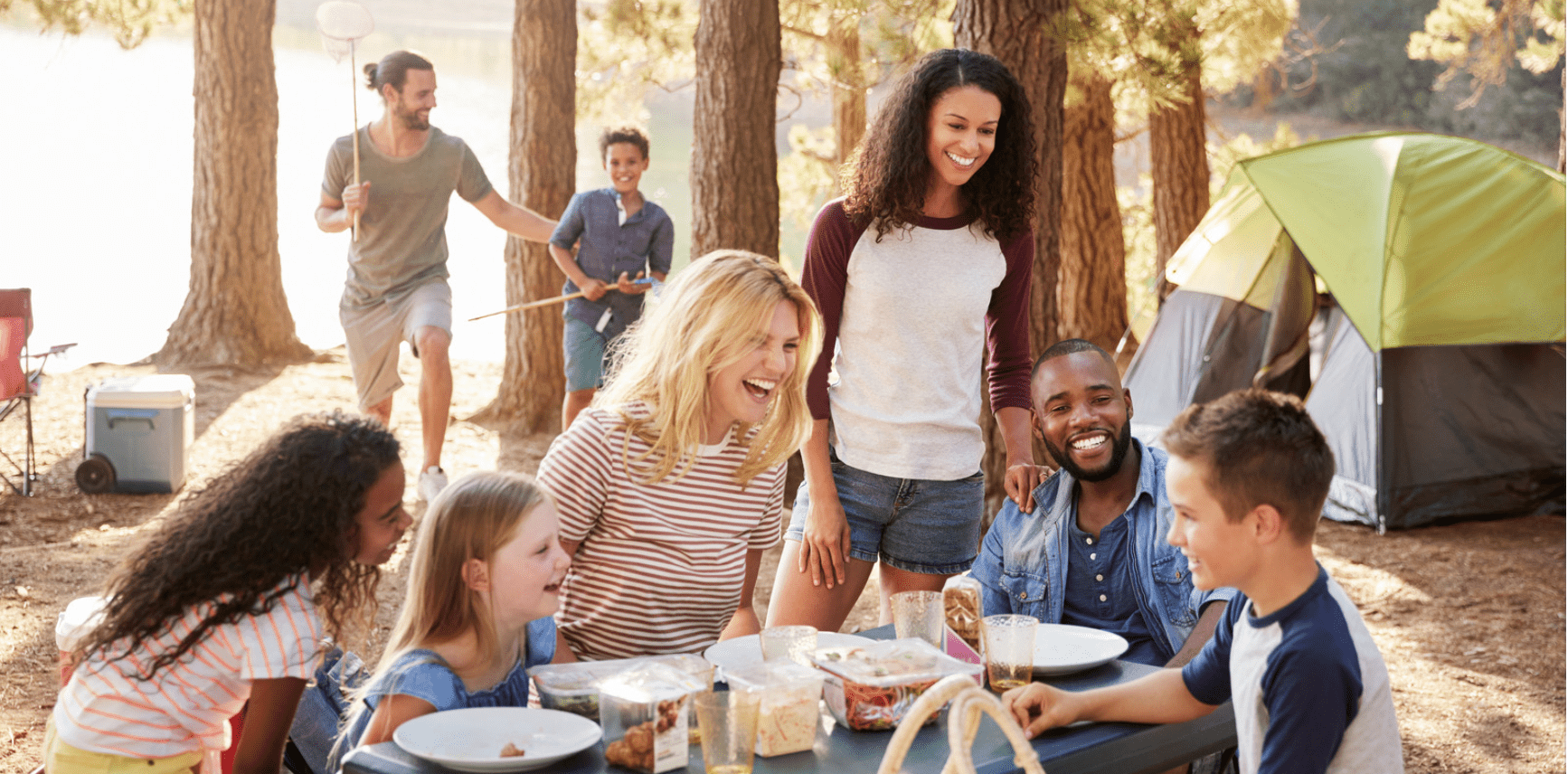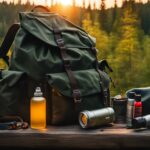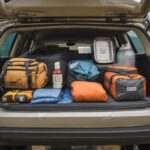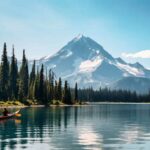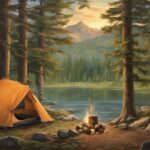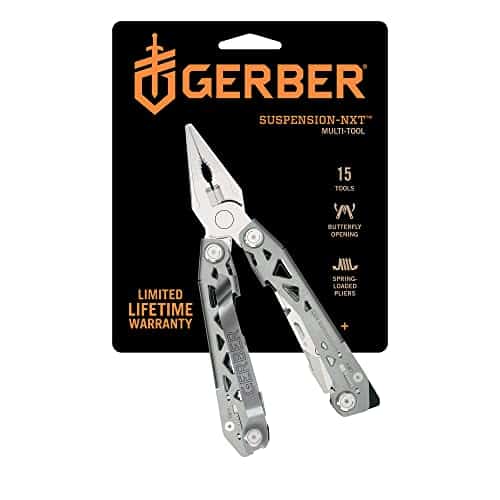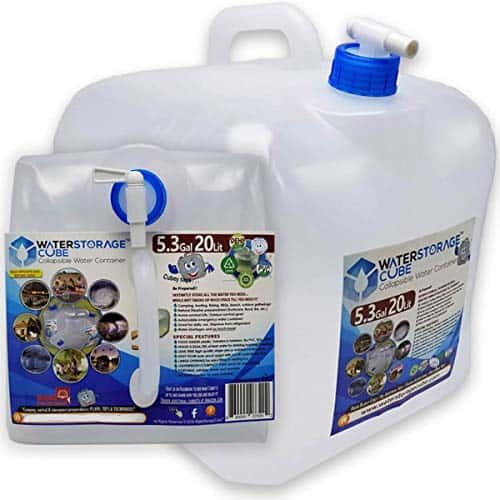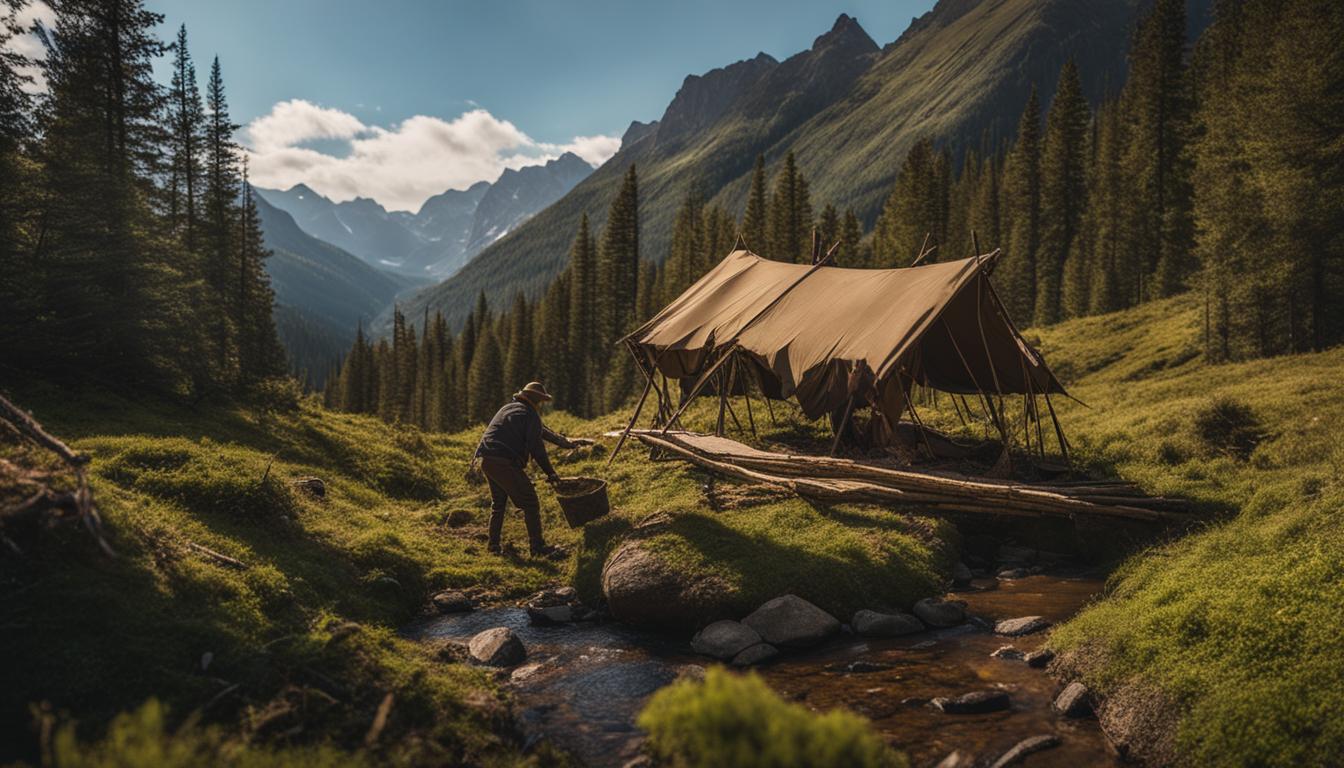Camping is a well-liked outdoor pastime that gives you the chance to appreciate nature and bond with loved ones. Having the correct essentials is crucial for a smooth camping trip. This guide offers a detailed list of camping essentials, such as gear, equipment, and a checklist to assist you in organizing and getting ready for your upcoming outdoor escapade.
Key Takeaways:
- Having the right camping gear and equipment is crucial for a successful outdoor adventure.
- Make sure to include items like tents, sleeping bags, camp chairs, and a camping stove in your camping checklist.
- Don’t forget essential tools, repair items, and hygiene products to ensure comfort and convenience during your camping trip.
- Efficient packing strategies and organization can maximize space and make it easier to find what you need.
- Adapt your camping essentials to cater to your specific needs, destination, and trip duration.
Choosing the Right Campsite Gear
The first step in preparing for a camping trip is to gather the necessary campsite gear. This includes a tent, sleeping bags, camp chairs, and other essentials. When choosing a tent, consider the size and weather conditions you will be camping in. Opt for a tent that is spacious enough for your group and offers protection from the elements. Sleeping bags should be selected based on temperature ratings and comfort preferences. Camp chairs provide a comfortable place to relax and unwind after a long day of outdoor activities.
Table: Campsite Gear Comparison
| Item | Features | Price |
|---|---|---|
| Tent | Spacious, weather-resistant | $150 |
| Sleeping bags | Temperature-rated, comfortable | $50 |
| Camp chairs | Portable, foldable | $20 |
When selecting a tent, make sure to choose one that suits your specific needs. If you’re camping with a large group, opt for a tent with multiple rooms or a spacious common area. If you’re camping in an area with unpredictable weather, look for a tent that offers strong wind resistance and waterproof features.
Sleeping bags come in various temperature ratings, so choose one that matches the weather conditions you’ll be facing during your camping trip. It’s also important to consider comfort, as a good night’s sleep is essential for an enjoyable outdoor adventure.
Camp chairs provide a comfortable seating option when you want to relax around the campfire or enjoy the beautiful scenery. Look for chairs that are portable, lightweight, and easy to fold and unfold. Consider additional features such as cup holders or built-in coolers for added convenience.
Essential Tools and Repair Items
When you’re out in the wilderness, it’s important to be prepared for any situation. Having the right tools and repair items can make all the difference in ensuring a smooth and enjoyable camping experience. Here are some essential items to include in your camping checklist:
- Multi-tool: A versatile tool that combines multiple functions in one, a multi-tool is a must-have for any camper. It can be used for cutting, opening cans, and even repairing gear. Choose one with a variety of tools such as pliers, screwdrivers, and a knife.
- Duct tape: Often referred to as the “handyman’s secret weapon,” duct tape is a valuable item to have in your camping kit. It can be used for quick fixes and temporary repairs, such as patching up a tear in your tent or fixing broken gear. Be sure to pack a roll of duct tape to save the day.
- Tent-pole repair sleeve: Accidents happen, and sometimes tent poles can get damaged or broken. A tent-pole repair sleeve is a handy tool that can save your camping trip. It allows you to fix broken tent poles on the spot, ensuring the stability of your shelter.
By including these essential tools and repair items in your camping checklist, you’ll be well-equipped to handle any unexpected situations that may arise during your outdoor adventure.
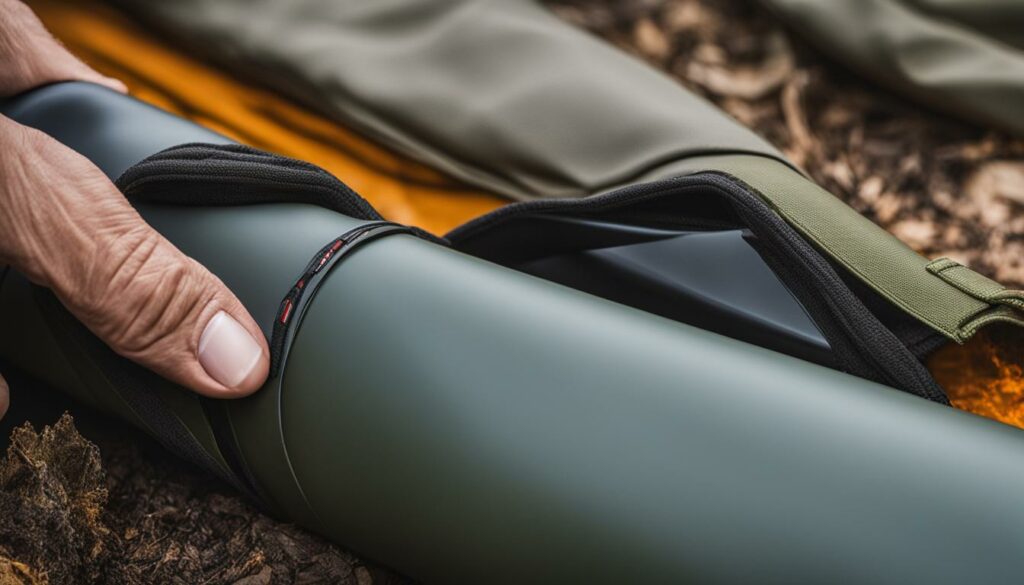
Table: Essential Tools and Repair Items
| Item | Description |
|---|---|
| Multi-tool | A versatile tool with various functions, such as pliers, screwdrivers, and a knife. |
| Duct tape | A strong adhesive tape that can be used for quick fixes and temporary repairs. |
| Tent-pole repair sleeve | A tool used to fix broken tent poles and ensure the stability of your shelter. |
Kitchen Essentials for Campsite Cooking
One of the highlights of camping is cooking delicious meals outdoors. To ensure you have everything you need for campsite cooking, it’s important to include the right kitchen essentials in your camping checklist. Here are some essential items to consider:
Camping Stove
A camping stove is a must-have for cooking meals at the campsite. It provides a convenient way to cook food and boil water. Look for a portable stove that is easy to set up and has adjustable heat levels. Whether you prefer a gas stove or a compact backpacking stove, make sure to bring enough fuel for the duration of your camping trip.
Cook Pots
Cook pots are essential for preparing and cooking food at the campsite. Choose lightweight and durable pots with lids that can accommodate your cooking needs. Look for pots with non-stick coatings for easy cleaning. Consider the size and capacity of the pots based on the number of people you will be camping with and the types of meals you plan to cook.
Utensils
Having the right utensils is crucial for campsite cooking. Include essentials such as knives, forks, spoons, and serving utensils in your camping checklist. Opt for durable and compact utensils that are easy to pack and clean. Consider bringing a can opener, bottle opener, and cooking utensils like spatulas and tongs for added convenience.
| Essential Kitchen Items | Description |
|---|---|
| Camping Stove | A portable stove for cooking meals and boiling water at the campsite. |
| Cook Pots | Durable pots with lids for preparing and cooking food. |
| Utensils | Knives, forks, spoons, and serving utensils for campsite cooking. |
By including these kitchen essentials in your camping checklist, you’ll be well-prepared to whip up delicious meals and enjoy tasty outdoor dining during your camping adventure.
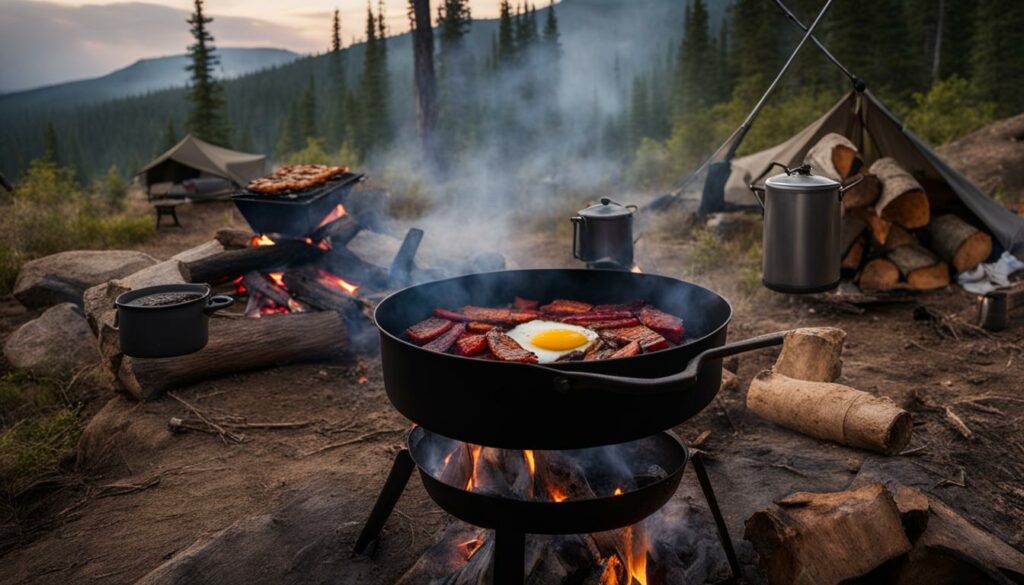
Comfort and Convenience Items
When it comes to camping, comfort and convenience can make a significant difference in your overall experience. Adding a few essential items to your camping checklist can enhance your outdoor adventure and ensure that you have a comfortable stay.
Camp Chairs
One of the must-have comfort items for any camping trip is a camp chair. Whether you want to relax by the campfire, enjoy a meal, or simply sit back and take in the beautiful surroundings, a camp chair provides a comfortable and portable seating option. Look for chairs that are lightweight, foldable, and durable, so you can easily transport them to your campsite.
Headlamps
When the sun goes down and darkness sets in, a reliable source of lighting becomes crucial. Headlamps are an essential tool for hands-free illumination during nighttime activities or trips to the bathroom. With an adjustable strap that fits around your head, headlamps provide reliable lighting and allow you to keep your hands free for other tasks. Look for headlamps with adjustable brightness settings and long battery life to ensure optimal performance throughout your camping trip.
Insect Repellent
While camping allows you to enjoy the great outdoors, it also exposes you to pesky insects such as mosquitoes and ticks. Protecting yourself from bug bites is essential for a comfortable camping experience. Include insect repellent in your camping checklist to ward off insects and prevent potential discomfort and health risks. Look for repellents with DEET or other effective active ingredients that can provide long-lasting protection against a variety of insects.
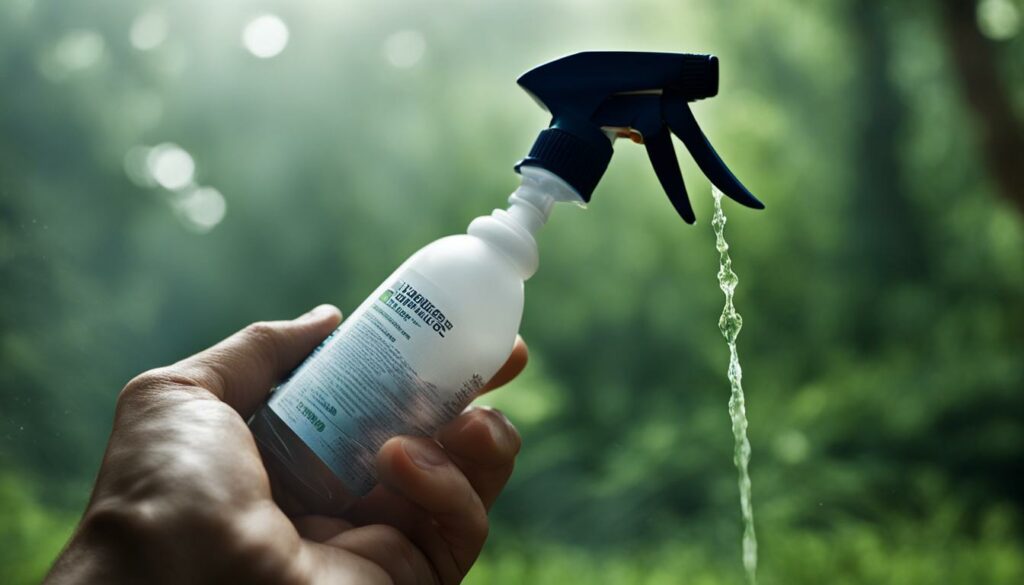
| Comfort and Convenience Items | Features |
|---|---|
| Camp Chairs | Lightweight, foldable, and durable design for portability and comfort. |
| Headlamps | Adjustable brightness settings and long battery life for hands-free illumination. |
| Insect Repellent | Effective protection against mosquitoes and ticks for a comfortable camping experience. |
The Indispensable Role of a Toiletry Bag
When it comes to camping essentials, one item that often goes overlooked is the toiletry bag. However, its role in ensuring hygiene, convenience, and emergency preparedness during camping adventures should not be underestimated. A toiletry bag provides a way to organize and store personal care products, toiletries, and other essential items, making them easily accessible when needed.
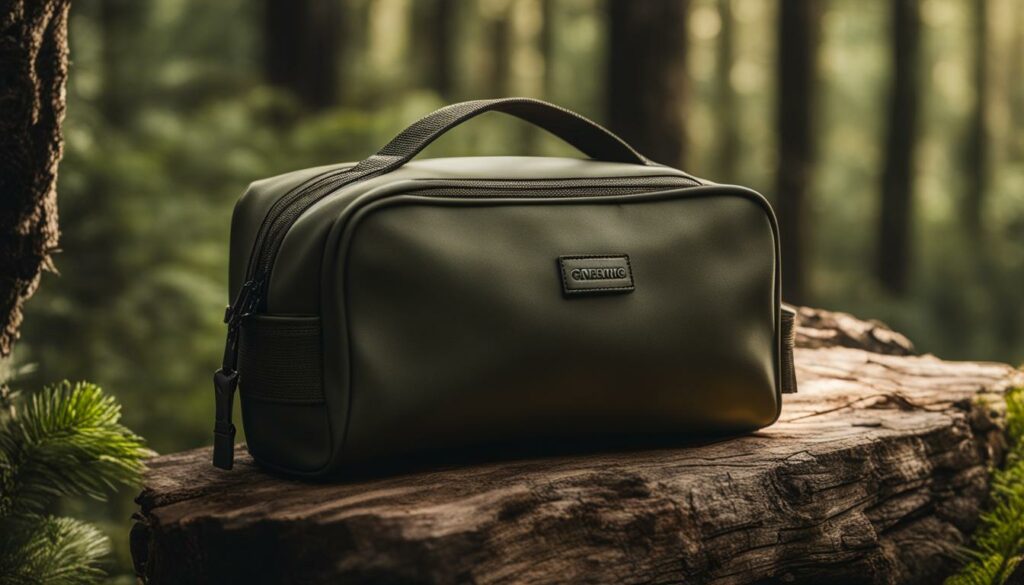
When choosing a toiletry bag for your camping needs, consider factors such as durability, space, and design. Look for a bag that is made of sturdy materials and has compartments or pockets to keep items organized. It should also be compact and lightweight, so it doesn’t take up too much space in your camping gear.
Table: Comparing Toiletry Bag Options
| Features | Basic Toiletry Bag | Hanging Toiletry Bag | Travel-Sized Toiletry Bag |
|---|---|---|---|
| Organization | Limited compartments | Multiple compartments | Minimal compartments |
| Space | Compact | Compact, but opens up for more space | Small and lightweight |
| Convenience | Easy to carry | Hangs for easy access | Small and portable |
| Price Range | $10-$20 | $20-$40 | $5-$10 |
Table: Comparing different types of toiletry bags based on their features, space, convenience, and price range.
A toiletry bag is a must-have item for every camper, providing a way to keep essential hygiene products organized and easily accessible. Don’t forget to include it in your camping checklist to ensure a comfortable and well-prepared outdoor adventure.
Essential Toiletry Items for Your Camping Toiletry Bag
When packing for a camping trip, it’s important not to forget the essential toiletry items that will help you maintain personal hygiene in the great outdoors. These items are crucial for your comfort and well-being during your camping adventure. Here are some must-have toiletry items for your camping toiletry bag:
- Toothbrush and Toothpaste: Keeping your teeth clean and fresh is essential, even when camping. Pack a toothbrush and toothpaste to ensure good oral hygiene.
- Shampoo and Soap: Maintaining cleanliness and freshening up is important. Bring travel-sized bottles of shampoo and soap to wash away dirt and sweat.
- Towel or Microfiber Towel: A towel is essential for drying off after swimming or showering. Consider using a microfiber towel as it is lightweight and quick-drying.
- Hand Sanitizer: In the absence of soap and water, hand sanitizer is a convenient alternative to keep your hands clean and germ-free.
- Deodorant: Stay fresh and odor-free throughout your camping trip by packing a travel-sized deodorant.
- Sunscreen: Protect your skin from the sun’s harmful rays by applying sunscreen regularly. Choose a sunscreen with a high SPF appropriate for outdoor activities.
These essential toiletry items will help you maintain personal hygiene and stay comfortable during your camping adventure. Pack them in a waterproof toiletry bag to keep everything organized and protected from moisture. Remember to check the expiration dates of your products and replenish any items that may be running low. with these toiletry essentials in your camping toiletry bag, you’ll be ready to enjoy the great outdoors without compromising your hygiene.
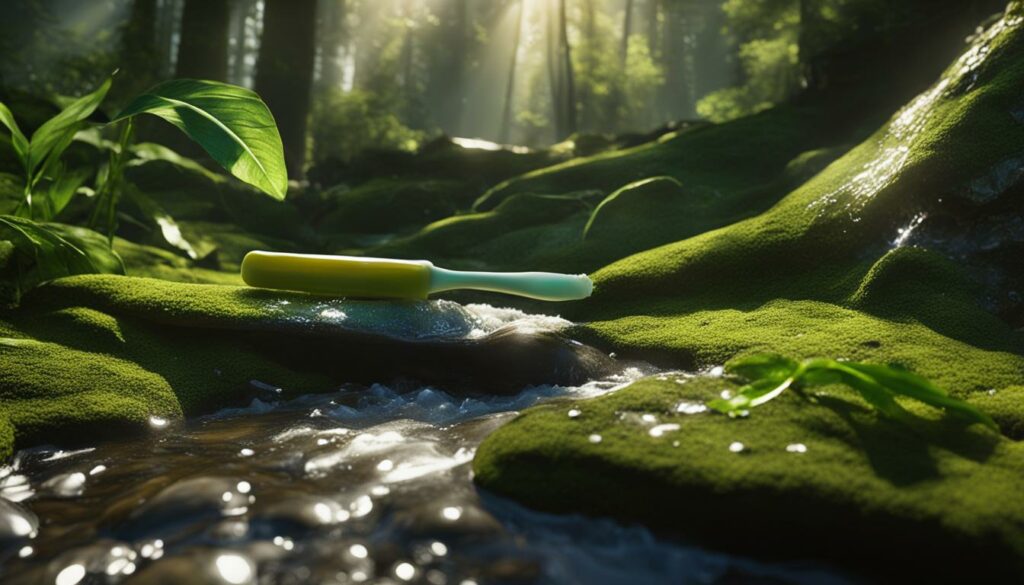
Maximizing Space in Your Toiletry Bag
Packing efficiently for a camping trip is essential to ensure you have all the necessary essentials without adding unnecessary bulk. One area where space optimization is particularly important is in your toiletry bag. By employing smart packing strategies, you can maximize the available space and keep your toiletries organized and easily accessible.
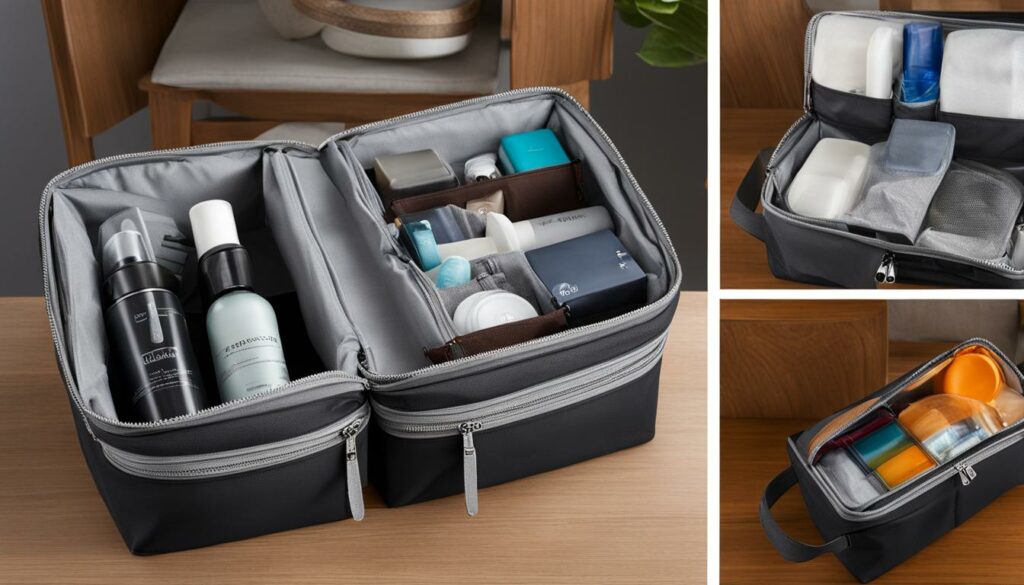
Space-Saving Strategies
Here are some space-saving strategies to consider:
- Roll and Stuff Method: Roll up clothing items and pack them tightly to save space. Stuff smaller items, such as socks or underwear, into shoes or gaps between larger items.
- Compartments and Zip Bags: Use compartments or zip bags to keep similar items together. This not only helps with organization but also saves space by eliminating air pockets.
- Travel-Size Containers: Transfer your toiletries into travel-size containers to minimize bulk. Only pack the amount you will need for the duration of your camping trip.
“Using these space-saving strategies can help you make the most of the limited space in your toiletry bag, allowing you to bring along all the essentials without compromising on organization or convenience.”
Stay Organized and Accessible
Keeping your toiletry bag organized is key to easily finding what you need. Consider using a toiletry bag with multiple compartments or pockets to separate different items. This way, you won’t have to rummage through everything to find a specific item. Additionally, designate a specific place for frequently used items, such as toothbrushes or hand sanitizers, to ensure easy access during your camping trip.
| Essentials to Include | Space-Saving Tip |
|---|---|
| Toothbrush and toothpaste | Opt for a compact toothbrush and travel-size toothpaste to save space. |
| Shampoo and conditioner | Pour shampoo and conditioner into small, leak-proof containers to reduce bulk. |
| Soap or body wash | Choose solid soap or travel-size body wash to minimize space. |
| Towel or microfiber cloth | Consider using a microfiber towel or cloth that is lightweight and dries quickly. |
| Deodorant | Opt for a travel-size or solid deodorant to save space. |
By following these tips and tricks, you can efficiently pack your toiletry bag and maximize the space available. Embrace the challenge of organizing your essentials and enjoy a hassle-free camping experience with a well-organized and space-saving toiletry bag.
Efficient Packing Strategies for Camping
When it comes to camping, efficient packing strategies are essential to ensure a smooth and organized trip. Balancing your load and organizing your items can make a significant difference in your camping experience. Here are some tips and tricks to help you pack efficiently for your next outdoor adventure.
Pack strategically
When packing for camping, it’s important to pack strategically to maximize space and minimize the weight of your load. Start by laying out all the items you plan to bring and categorize them into groups, such as clothes, toiletries, and cooking equipment. This will help you visualize how much space each category will take up in your camping bag.
Next, pack heavier items closer to your back to maintain balance and distribute weight evenly. This will prevent strain on your back and shoulders while hiking or walking to your campsite. Lighter items, such as clothes and sleeping bags, can be packed on top to fill any gaps and provide cushioning for your heavier gear.
Optimize your storage
To make the most of your available space, consider using storage solutions such as compression bags and packing cubes. Compression bags allow you to compress your clothes and other soft items, reducing their volume and creating more space in your camping bag. Packing cubes help keep your belongings organized and prevent them from shifting during transportation.
Additionally, utilize the pockets and compartments in your camping bag to store smaller items and accessories. This will help you easily locate and access essential items such as your flashlight, multi-tool, or insect repellent when needed.
Create a checklist
To ensure you don’t forget any important items, create a checklist before you start packing. Divide your checklist into different categories, such as camping gear, cooking supplies, and personal items. This will help you stay organized and ensure you have everything you need for your camping trip. As you pack each item, check it off your list to keep track of your progress.
By following these efficient packing strategies, you can make the most of your camping experience and have a stress-free trip. Remember to pack strategically, optimize your storage, and create a checklist to stay organized. Happy camping!

Catering to Your Specific Needs
When it comes to camping, catering to your specific needs is essential for a successful and enjoyable outdoor adventure. Whether you’re planning a solo camping trip, a family vacation, or a group getaway, tailoring your camping essentials to meet your unique requirements is crucial. Consider factors such as the destination, trip duration, and personal preferences when selecting gear and essentials.
Start by assessing the specific needs of your camping trip. Are you heading to a remote wilderness area or a developed campground? Will you be hiking long distances or driving up to your campsite? Understanding the nature of your trip will help you determine the necessary camping gear. For example, if you’re embarking on a backpacking adventure, lightweight and compact gear will be a priority. On the other hand, if you’re driving to a campground, you may have more flexibility in terms of equipment and supplies.
Another aspect to consider is the duration of your camping trip. If you’re planning an overnight stay, you may not require extensive cooking equipment or a large tent. However, for longer trips, it’s important to ensure you have enough provisions and a comfortable shelter to accommodate your needs. Think about the number of meals you’ll be preparing, the storage capacity for food and water, and the sleeping arrangements for each individual.
Lastly, take into account your personal preferences and comfort level. Are you someone who enjoys lounging by the campfire, or do you prefer more active outdoor activities? Do you have any specific dietary restrictions or medical conditions that require special attention? By tailoring your camping essentials to cater to these preferences and needs, you can enhance your overall camping experience and ensure a memorable adventure.
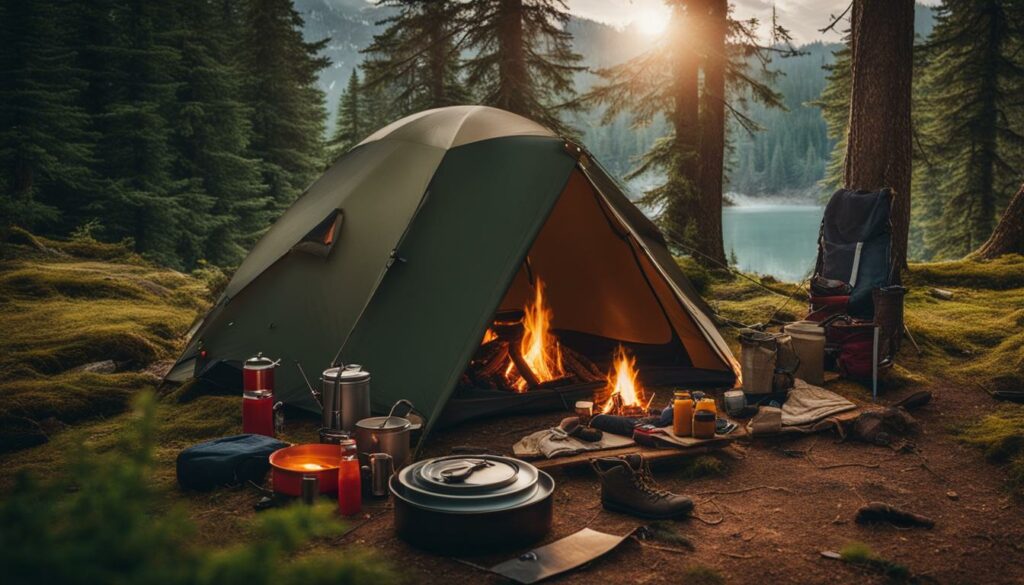
Essential Camping Gear for Various Needs:
| Specific Need | Essential Gear |
|---|---|
| Solo Camping | Tent, sleeping bag, cooking stove, multi-tool |
| Family Camping | Larger tent, family-sized sleeping bags, camp chairs, portable grill |
| Adventure Camping | Hiking backpack, lightweight tent, trekking poles, water filtration system |
| Luxury Camping | Large canvas tent, comfortable bedding, camping kitchen set, hammock |
Remember, your camping essentials should be tailored to your specific needs, ensuring you have everything required for a safe, comfortable, and enjoyable outdoor experience. By carefully selecting the right gear, equipment, and supplies, you can make the most of your camping trip and create lasting memories in the great outdoors.
Conclusion
Planning and preparing for a camping trip can be an exciting and rewarding experience. Whether you’re a seasoned camper or new to the great outdoors, having the right camping essentials is crucial for a successful adventure. From gear and equipment to toiletries and cooking supplies, it’s important to make a checklist and ensure you have everything you need.
By following this comprehensive guide, you can create a camping checklist that covers all the essentials. From choosing the right campsite gear, including tents and sleeping bags, to packing efficient toiletry items and maximizing space in your toiletry bag, each aspect of planning is essential for a comfortable and enjoyable camping trip.
Remember to cater to your specific needs, considering factors such as the destination, trip duration, and personal preferences. Whether you’re heading to the mountains or the beach, having the appropriate camping gear is crucial. Tailor your packing list to suit your unique camping experience and make the most of your time in nature.
So, grab your camping essentials, get out there, and embark on a memorable outdoor adventure. Happy camping!
What Are Some Essential Camping Items That Shouldn’t Be Forgotten?
When planning a camping trip, it’s crucial to have the ultimate camping essentials checklist to ensure you have everything you need. Don’t forget to pack a tent, sleeping bag, first aid kit, portable stove, and flashlight. These items will help make your camping experience safe and enjoyable.
FAQ
What are the essential items for camping?
The essential items for camping include a tent, sleeping bags, camp chairs, a camping stove, cook pots, utensils, a toiletry bag, and personal care products such as a toothbrush and toothpaste.
How do I choose the right tent for camping?
When choosing a tent, consider the size and weather conditions you will be camping in. Opt for a tent that is spacious enough for your group and offers protection from the elements.
What tools and repair items should I bring on a camping trip?
It’s important to have a multi-tool, duct tape, and a tent-pole repair sleeve on hand for any camping trip. These items can be used for various purposes such as cutting, repairing gear, and fixing broken tent poles.
What kitchen essentials should I include in my camping checklist?
For campsite cooking, make sure to include a camping stove, cook pots, and utensils in your checklist. A camping stove provides a convenient way to cook meals, while cook pots are necessary for preparing food and utensils are needed for eating and serving.
What comfort and convenience items should I bring for camping?
You should bring camp chairs, headlamps, insect repellent, and sunscreen for added comfort and convenience during your camping trip. Camp chairs provide a place to relax, headlamps offer hands-free illumination, and insect repellent and sunscreen protect against bugs and UV rays.
What is the role of a toiletry bag in camping?
A toiletry bag is essential for organizing and storing personal care products, toiletries, and other essential items during camping adventures. It ensures hygiene, convenience, and emergency preparedness in the great outdoors.
What toiletry items should I pack for camping?
Essential toiletry items for camping include a toothbrush, toothpaste, shampoo, soap, and any other personal care products you may need for your hygiene routine in the great outdoors.
How can I maximize space in my toiletry bag for camping?
To maximize space in your toiletry bag, explore different packing strategies such as the roll and stuff method. Use compartments, zip bags, or travel-size containers to keep similar items together and organized.
What are some efficient packing strategies for camping?
Balancing your load, organizing your items into groups, and packing heavier items closer to your back are efficient packing strategies for camping. These strategies help maintain balance, distribute weight evenly, and make it easier to find what you need.
How can I cater to my specific needs when packing for camping?
When packing for camping, consider factors such as the destination, trip duration, and personal preferences. Tailor your packing list to include the necessary camping gear and essentials that meet your specific needs.
What should I keep in mind when planning a camping trip?
When planning a camping trip, make sure to have the right camping essentials, from gear and equipment to toiletries and cooking supplies. This ensures a successful and enjoyable camping adventure.

